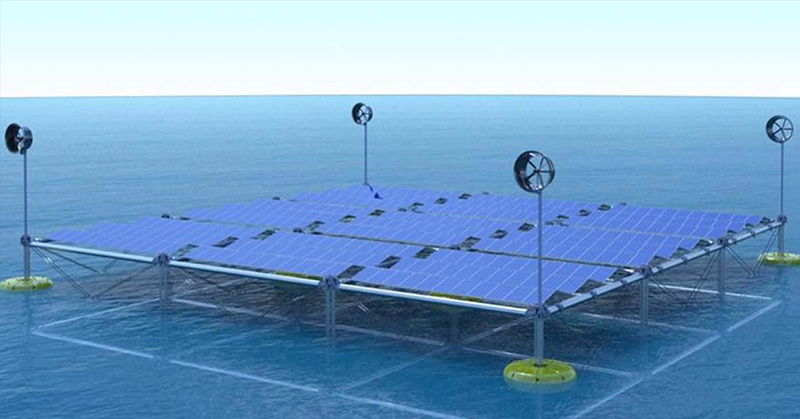Scientists and engineers around the world have been working to come up with innovative solutions for more sustainable, environmentally-friendly energy generation. While there have been several promising projects, one German company has come up with a solution that has stood out from the rest: floating solar panels.
As our world has become increasingly advanced and more reliant on technology, the global demand for energy has been rising. This need poses two main questions:
- Will we have enough affordable energy in the future?
- What will we do in the long term?
Currently, more than 60 percent of the energy generated in the United States comes from fossil fuels [1]. Globally, nearly 85 percent of the world’s energy is produced by oil, coal, and gas [2].
This is problematic for a number of reasons, the most significant of which is that the burning of coal, natural gas, and oil for electricity is the largest contributor of greenhouse gas emissions worldwide [3]. Additionally, these fuel sources are non-renewable, which makes them an inadequate long-term solution for global energy generation.
SINN Power
SINN Power was founded by Dr. Phillipp Sinn, and offers clean energy solutions to people living near coasts all over the world. Through partnerships with academia and members of the power industry, the company has managed to take their idea from patent to prototype in just two years and is now operating fully-functional prototypes at their research space in Heraklion, Greece.
The company’s main goal is “to turn the unlimited power of ocean waves into clean and cost-efficient energy that is accessible for everyone.” [4]
Floating Solar Panels
SINN Power’s prototype is a hybrid platform that generates renewable energy from waves, wind, and solar sources.
The platform uses what is called wave energy conversion (WEC). While WEC is not a brand new concept, and there have been a number of innovations that have taken place in the field over the last several years, SINN’s modular design is unique because of how easy it is to connect and expand the platform, opening up the possibility for a variety of different combinations [5].
The platform uses electrical sensors that are IP68-rated, which means that they are waterproof up to a certain length of time [6]. These sensors continuously send data to diagnostic centers, allowing them to detect anomalies early, and prevent potential failures.
According to Sinn, a service plan for customers can be easily optimized, and they are able to anticipate repairs before major damage occurs by analyzing output patterns. Each unit is made up of four integrated converters that generate power through wave energy relative to the water conditions.
In areas where there is low potential for wave energy (meaning it’s not very wavy), they can add 20kW photovoltaic cells to generate solar power, as well as up to four small 6kWp wind turbines to generate wind power. This allows them to take advantage of the environmental conditions of the area, and Sinn says there is no limit to the number of units that can be added [5].
“It’s always the same, it’s super modular,” says Sinn. “We can always use the same parts, the same electronics regardless of which configuration is constructed. So, with this strategy, we want to get into volume, get the practice low, and then it’s so we can show [sic] that wave power is really attractive against solar,” [5].
Sinn explains that this modular design has been an important factor in allowing them to develop flexible maritime technologies with a wide variety of applications.
“The floating platform can supply renewable energy to islands across the world, for example, and contribute to the worldwide implementation of offshore wind farms,” he said [5].
Read: Enormous Floating Solar Farms Can Extract Carbon Dioxide from Seawater to Replace Fossil Fuels
Commercialization on the Horizon
Five years after its inception, SINN Power is preparing to commercialize their technology and start marketing their platform, with the hope that they will be able to start generating power for coastal communities in the near future [4].
In addition to the innovative work that is being done by SINN Power, there are several other initiatives and projects that are being developed around the world, particularly in the solar energy field. Solar ovens, solar homes, and solar farms are being designed to take the place of fossil fuels, and scientists have developed a liquid fuel capable of storing the sun’s energy for up to eighteen years.
Researchers have even invented a device that can generate energy from the rain, and a team of scientists from Saudi Arabia, the US, China, and Hong Kong have developed a technology that creates fuel from carbon dioxide using the motion of waves.
As the world’s brightest minds continue to work on new technologies that will allow us to generate electricity and power from renewable resources, there is hope for a future in which energy and electricity is affordable and available to everyone, without damaging our environment.
Keep Reading: Project combines hemp and solar to go totally off grid
- https://www.eia.gov/tools/faqs/faq.php?id=427&t=3
- https://ourworldindata.org/energy
- https://www.epa.gov/ghgemissions/global-greenhouse-gas-emissions-data
- https://www.sinnpower.com/
- https://www.forbes.com/sites/scottsnowden/2020/05/22/first-floating-ocean-hybrid-platform-can-generate-power-from-waves-wind-and-solar/
- https://www.trustedreviews.com/opinion/what-is-ip68-ip-ratings-explained-2947135

